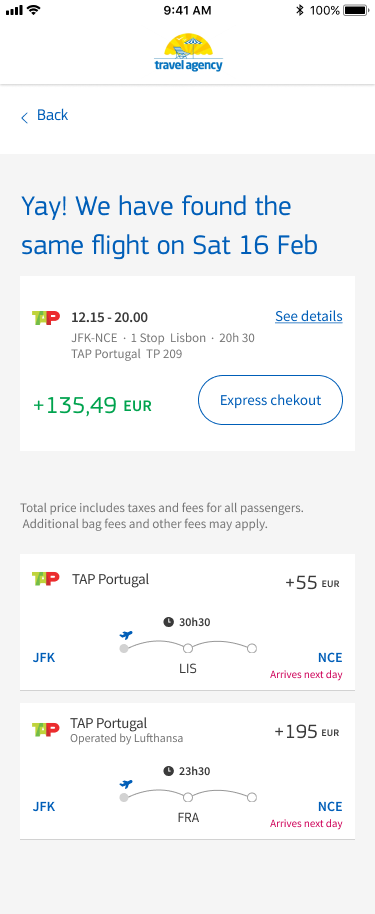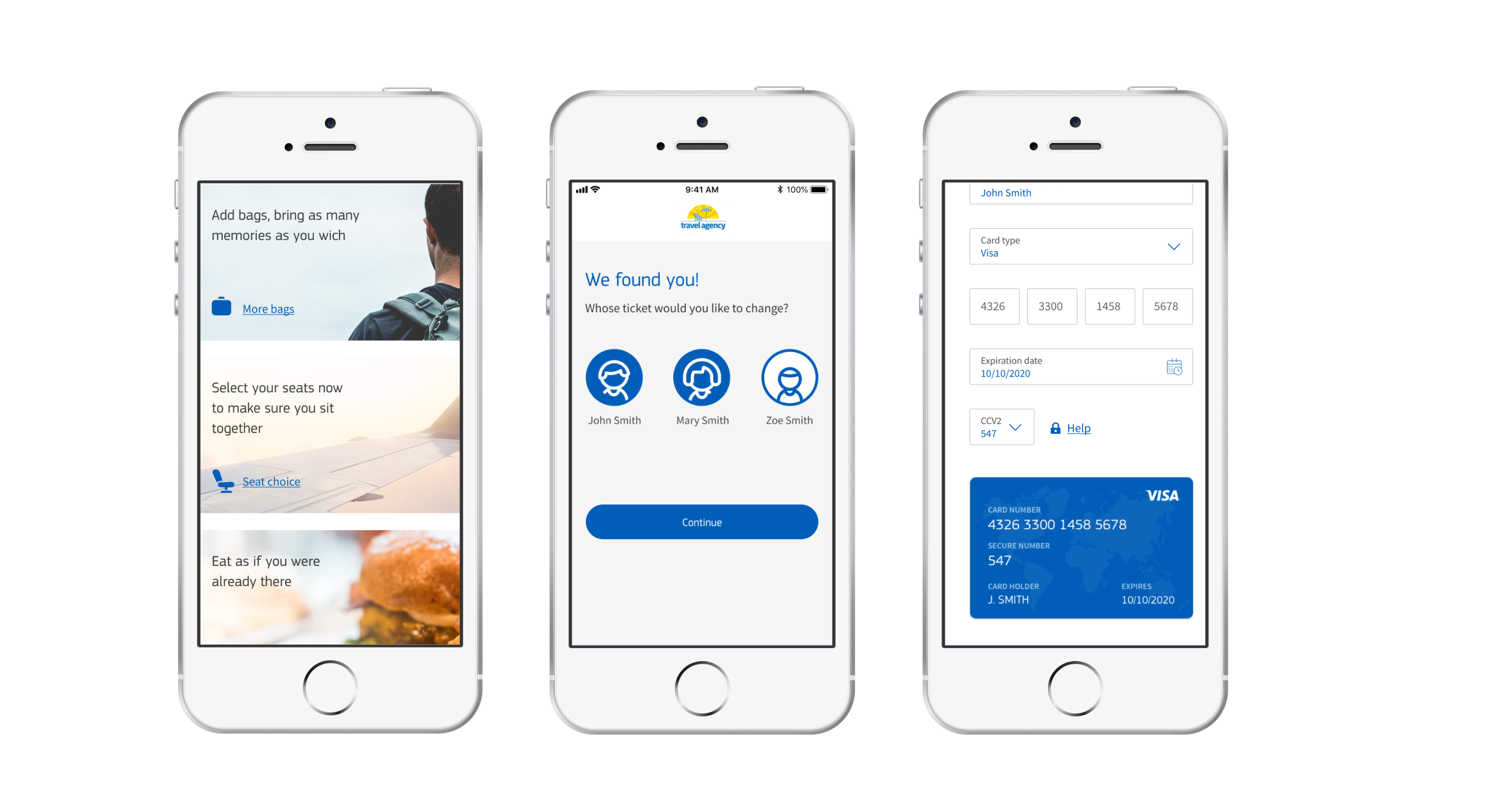CLIENT
Amadeus
ROLE
Lead Product Design
YEAR
2018
E-Power is Amadeus' lead B2B and B2C product for online travel agencies and consolidators.
Amadeus Ticket Changer (ATC) was the new product that was being built for airlines to give their customers post-booking capabilities such as ticket change or adding ancillary services.
When I started working for Amadeus in 2017, the company was going through a transformational period. The E-Power product and engineering team had recently worked with a design agency to kick things off to design a new E-Power, but it was far from being finished.
On the other hand, the team had also recently signed off the contract for building ATC for Amadeus Global and was hoping to hit two birds with one stone by building a single product framework.
My Role
I wore different hats throughout the process of building these products.
- Project Lead
I was working with three different teams (and their respective product managers) on various parts of the journey, bridging the gap between them, VP of Product and VP of Engineering by creating a collaborative environment, finding ways to encourage user-driven thinking, and helping engineering with scoping and sequencing.
- Lead Product Designer
I had the chance of introducing a new way of working for the teams by creating user journeys, defining IA, establishing visual design, the design system, and finally creating prototypes to validate with our clients. I've also managed to continue running design sprints for the product and engineering teams - which helped us capture key problems and assumptions.
The Challenge(s)
E-Power was a product that started being built in the late 2000s and considered to be a "legacy" product.
Throughout the years, it was Frankensteinized by adding every customer request or flexibility that every country market required while not applying any customer-centric design approach.
For ATC, it was quite different. Now it had a quite bright future, but it also had to bear in mind the kind of flexibility of her brother had. It was also quite important for Amadeus's plans for the next decade with the implementing of NDC.
Goals

Making sure new E-Power is designed the right way with the help of key customers across the market.

Setting and executing the vision that is required for ATC: a white label product that has all the capabilities and the flexibility for the market.

Both products having the right sets of features and customisation options for all packages.
The Research
We had to make sure what pain-points our customers had with E-Power as no central feedback system was created for the product previously. Since everything that was added to the product was either one-off customer requests or some over-engineered features, we wanted to set our key objectives for the research.
1- Understand the E-Power customer journey from pre-sales to adoption for travel agents.
2- Understanding the solutions E-power is presenting from pre-booking to post-trip.
3- Identify unmet end-user needs and provide opportunities for clients
4- Invalidating ideas by presenting design prototypes.
For these initial objectives, we had the chance of working with a user research company named System Concepts. While these objectives evolved throughout the process, some of them stayed relevant at all times to build the feedback loop, especially objectives 3 and 4.
Design Sprints
I wanted to maintain the user-centric approach - which had been introduced to the team by an external design agency just before I joined.
As soon as the initial scoping session for the first version of both products was done - we've set out the build a rough product roadmap and list all relevant design requirements for it.
In the following weeks, I've run design sprints to build mini customer journey prototypes to share with clients. As I was the only UX/UI designer on both projects, the most important thing for me was to make sure we've got the right kind and amount of feedback from the clients with these sessions.

The Approach
Having the same engineering and product resources on both products meant that ideally, we could build a shared design library and iterate accordingly.
The key thing for us was to keep it simple and avoid the design library turning into a "design system" in the minds of managers or engineering.
As soon as we agreed on initial design concepts for both products, I've started to break these pages down into components and iterated on them. While both products were aiming the travel industry as a whole, E-Power was quite detailed and complex in terms of customer journeys - as much as any other metasearch products like Skyscanner or Mondo.
Problem Round I
E-POWER
ATC
Problem: It was really hard to maintain the old product
- engineering, or design-wise.
Solution: We needed to make the jump, and start with something simple, instead of planning with big design upfront.
Problem: There was no white-label product like ATC built for Amadeus before.
Solution: Neither for any other company! We had an exciting opportunity to build something new, and we could potentially use any design/engineering resource.






The new product had the idea of "time-saving moments" when it came to amending a booked flight.
Problem Round II
E-POWER
ATC
Problem: Personas. Why it'd have to be personas? No, but seriously, if you are designing for such a massive project, where do you ever stop?
Solution. No personas. Not even proto-personas. Not that they don't usually work, but it's very hard to categorize with so many airlines, agencies and itineraries involved. Instead, we focused on giving those capabilities to build what's right for them to our clients, with the idea of a WYSIWYG editor in a different product package.
Problem: How do you build a white-label ticket changer product for dozens of airlines without thinking about the consequences of their customer experience or branding?
Solution: Templates to get them started. And if they would like to add/remove a feature that's perfectly fine too, as everything in ATC was always designed and built to be modular. Need to show destinations on your landing screen? Sure. Would you like an upsell module with that?

Problem Round III
E-POWER
ATC
Problem: Because it was sold in over 100+ countries, the product was filled with hacks for a certain language or a mandate. This also slowed down any progress previously as there were always consequences to any design change.
Solution: Focus on the overlapping themes, design for the majority of markets and think of it like an "E-Power Lite".
Problem: Every airline had different ancillary services and even more rules and restrictions about changing a booking.
Solution: Going through the data in Amadeus led us to promote the right features. In this case, the best performing services were the focus.


PROTOTYPE(S)
One of the earlier prototypes we tested with clients was for Amadeus Ticket Changer with included the fast-checkout capability (shown on the right)
I've managed to design over 60 lo-fi & hi-fi prototypes over the period of the project and test more than half of them.
Measuring Success
What made this project a great success was continuous communication with key customers. They helped us shape our product roadmap greatly.
Many clients have repeatedly said how these products will help them achieve their business goals - especially with the help of personalized offers on ancillary sales.
It also helped the company secure many contract renewals and RFPs happening towards the end of Q3 & Q4.
"I can't wait for our team to use this! It seems to tick all the boxes for us for the next few years."
- ECOM of a leading OTA based in UK

...and learnings
You see, we weren't focusing on making these products unlike anything has ever seen. That's rarely the goal in big companies. On the contrary, we wanted everyone to have a familiar experience, so it would not feel like a white label product for the end customer, for people like you and me.
While this sounds easy, but it wasn't. It's not like any other redesign of any booking site where people design for a single traveler with 1 bag with one of three payment options. We had over 30 payment methods, and not all card numbers starting with a specific number was supposed to belong to a card type. Or changing your itinerary post-departure, when you're not the master passenger.
When I left, the company was still working on their go-to-market with both products. I also knew that it was just the beginning, especially with NDC coming in the next year.
However, this product and the journey we've been through helped me understand some of the challenges of complex apps, and what some other products would call edge or narrow cases could be integral to designing a complex white-label B2B2C product. In fact, for the first time in my career, I was the one who didn't come up or worried about edge cases!